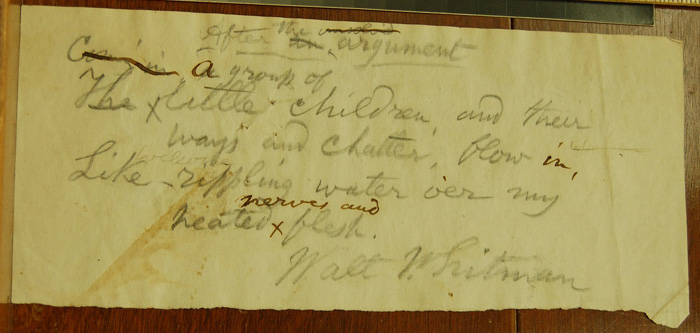Module 6: Primary Sources
2. Walt Whitman: “After the Argument” #
This manuscript, featuring an early version of the poem “After the Argument,” was likely written in 1890 or early 1891, shortly before the poem’s publication.
This example clearly illustrates how the TEI transcr module can be applied to verse texts as well. The entire poem is encoded inside <lg type="poem">, containing a heading (<head>) and two verse lines (<l>), in which physical line breaks have been maked with <lb> elements. As will be clear from the facsimile, this short manuscript features some complex editorial traces. Sequential deletions (<del>) and additions (<add>) are grouped into substitutions (<subst>). Moreover, inside the substitutions, the exact order of the editing interventions is specified by means of a sequence number in a @seq attribute, making explicit that the deletions occurred before the additions.
Note
The @seq attribute is a more advanced concept documented in chapter 11 Representation of Primary Sources of the TEI Guidelines. Notice how this explicit sequence number is not strictly needed here, as deletions logically precede additions, and only one deletion is involved.This example illustrates nicely how additions and deletions can nest. In both cases in the example, an addition contains further deletions. The @rend attribute is used on <del> and <add> in order to encode the way in which deletions ("overstrike" or "overwrite") and additions ("insertion", "overwrite", "unmarked") have been realised on the manuscript. An additional @place attribute on <add> indicates if the additions are located "supralinear", "over" existing text, or "inline".
Page breaks are indicated with <pb> elements, indicating the type of the manuscript page ("recto" or "verso") with the @type attribute. The @facs attribute points to a digital facsimile of the page indicated with the <pb> element.
Bibliography
- Bentham, Jeremy. 1802. “Manuscript JB/116/010/001.” Manuscript encoded and made available by the Transcribe Bentham project at https://transcribe-bentham.ucl.ac.uk/td/JB/116/010/001.
- Whitman, Walt 1890. “After the Argument.” Manuscript encoded and made available by the Walt Whitman Archive at https://www.whitmanarchive.org/manuscripts/transcriptions/loc.00001.html.



